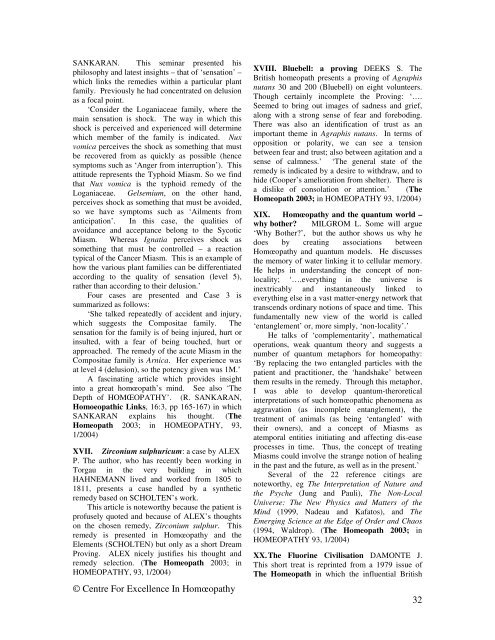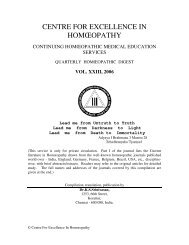Create successful ePaper yourself
Turn your PDF publications into a flip-book with our unique Google optimized e-Paper software.
SANKARAN. This seminar presented his<br />
philosophy and latest insights – that of ‘sensation’ –<br />
which links the remedies within a particular plant<br />
family. Previously he had concentrated on delusion<br />
as a focal point.<br />
‘Consider the Loganiaceae family, where the<br />
main sensation is shock. The way in which this<br />
shock is perceived and experienced will determine<br />
which member of the family is indicated. Nux<br />
vomica perceives the shock as something that must<br />
be recovered from as quickly as possible (hence<br />
symptoms such as ‘Anger from interruption’). This<br />
attitude represents the Typhoid Miasm. So we find<br />
that Nux vomica is the typhoid remedy of the<br />
Loganiaceae. Gelsemium, on the other hand,<br />
perceives shock as something that must be avoided,<br />
so we have symptoms such as ‘Ailments from<br />
anticipation’. In this case, the qualities of<br />
avoidance and acceptance belong to the Sycotic<br />
Miasm. Whereas Ignatia perceives shock as<br />
something that must be controlled – a reaction<br />
typical of the Cancer Miasm. This is an example of<br />
how the various plant families can be differentiated<br />
according to the quality of sensation (level 5),<br />
rather than according to their delusion.’<br />
Four cases are presented and Case 3 is<br />
summarized as follows:<br />
‘She talked repeatedly of accident and injury,<br />
which suggests the Compositae family. The<br />
sensation for the family is of being injured, hurt or<br />
insulted, with a fear of being touched, hurt or<br />
approached. The remedy of the acute Miasm in the<br />
Compositae family is Arnica. Her experience was<br />
at level 4 (delusion), so the potency given was 1M.’<br />
A fascinating article which provides insight<br />
into a great homœopath’s mind. See also ‘The<br />
Depth of HOMŒOPATHY’. (R. SANKARAN,<br />
Homoeopathic Links, 16:3, pp 165-167) in which<br />
SANKARAN explains his thought. (The<br />
Homeopath 2003; in HOMEOPATHY, 93,<br />
1/2004)<br />
XVII. Zirconium sulphuricum: a case by ALEX<br />
P. The author, who has recently been working in<br />
Torgau in the very building in which<br />
HAHNEMANN lived and worked from 1805 to<br />
1811, presents a case handled by a synthetic<br />
remedy based on SCHOLTEN’s work.<br />
This article is noteworthy because the patient is<br />
profusely quoted and because of ALEX’s thoughts<br />
on the chosen remedy, Zirconium sulphur. This<br />
remedy is presented in Homœopathy and the<br />
Elements (SCHOLTEN) but only as a short Dream<br />
Proving. ALEX nicely justifies his thought and<br />
remedy selection. (The Homeopath 2003; in<br />
HOMEOPATHY, 93, 1/2004)<br />
© Centre For Excellence In Homœopathy<br />
XVIII. Bluebell: a proving DEEKS S. The<br />
British homeopath presents a proving of Agraphis<br />
nutans 30 and 200 (Bluebell) on eight volunteers.<br />
Though certainly incomplete the Proving: ‘….<br />
Seemed to bring out images of sadness and grief,<br />
along with a strong sense of fear and foreboding.<br />
There was also an identification of trust as an<br />
important theme in Agraphis nutans. In terms of<br />
opposition or polarity, we can see a tension<br />
between fear and trust; also between agitation and a<br />
sense of calmness.’ ‘The general state of the<br />
remedy is indicated by a desire to withdraw, and to<br />
hide (Cooper’s amelioration from shelter). There is<br />
a dislike of consolation or attention.’ (The<br />
Homeopath 2003; in HOMEOPATHY 93, 1/2004)<br />
XIX. Homœopathy and the quantum world –<br />
why bother? MILGROM L. Some will argue<br />
‘Why Bother?’, but the author shows us why he<br />
does by creating associations between<br />
Homœopathy and quantum models. He discusses<br />
the memory of water linking it to cellular memory.<br />
He helps in understanding the concept of nonlocality;<br />
‘….everything in the universe is<br />
inextricably and instantaneously linked to<br />
everything else in a vast matter-energy network that<br />
transcends ordinary notions of space and time. This<br />
fundamentally new view of the world is called<br />
‘entanglement’ or, more simply, ‘non-locality’.’<br />
He talks of ‘complementarity’, mathematical<br />
operations, weak quantum theory and suggests a<br />
number of quantum metaphors for homeopathy:<br />
‘By replacing the two entangled particles with the<br />
patient and practitioner, the ‘handshake’ between<br />
them results in the remedy. Through this metaphor,<br />
I was able to develop quantum-theroretical<br />
interpretations of such homœopathic phenomena as<br />
aggravation (as incomplete entanglement), the<br />
treatment of animals (as being ‘entangled’ with<br />
their owners), and a concept of Miasms as<br />
atemporal entities initiating and affecting dis-ease<br />
processes in time. Thus, the concept of treating<br />
Miasms could involve the strange notion of healing<br />
in the past and the future, as well as in the present.’<br />
Several of the 22 reference citings are<br />
noteworthy, eg The Interpretation of Nature and<br />
the Psyche (Jung and Pauli), The Non-Local<br />
Universe: The New Physics and Matters of the<br />
Mind (1999, Nadeau and Kafatos), and The<br />
Emerging Science at the Edge of Order and Chaos<br />
(1994, Waldrop). (The Homeopath 2003; in<br />
HOMEOPATHY 93, 1/2004)<br />
XX. The Fluorine Civilisation DAMONTE J.<br />
This short treat is reprinted from a 1979 issue of<br />
The Homeopath in which the influential British<br />
32




